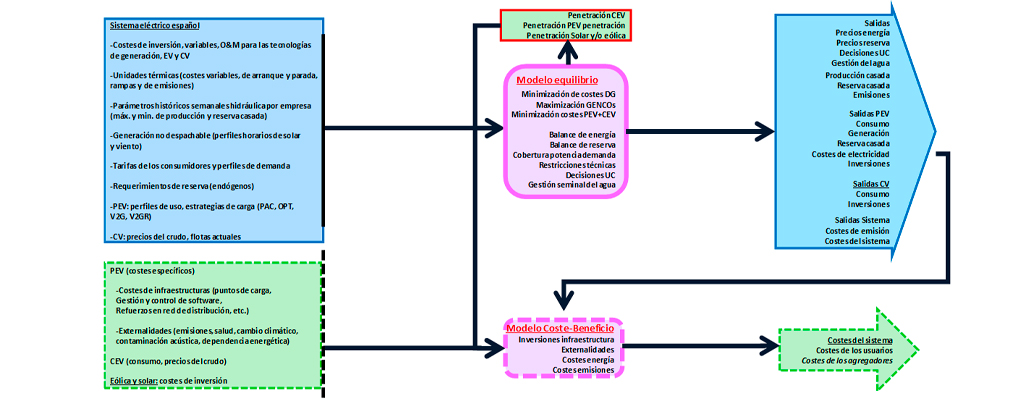CEVESA is a dynamic generation expansion planning model for the Spanish power system (assumed as a single-node), that considers both investments made by distributed customers in Distributed Energy Resources (DER: generation and storage) and by generation companies (GENCOs) in Centralized Resources (CR: conventional thermal generation plants, renewable generation and centralized storage). It is also connected with the transport sector by including investments decisions on Electric Vehicles (PEV) and Internal Combustion Engine Vehicles (CEV), considering infrastructure deployment, fuel, and social and environmental costs of both technologies. The model is based on a conjectural-variation equilibrium with price-response conjectures with hourly detail, energy and endogenous secondary reserve requirements, ramping constraints, and start-ups and shut-downs. The equilibrium model is a one-only level model for both investment and operation decisions, solved using an equivalent quadratic minimization problem, which simplifies its resolution.
In the power system GENCOs maximize their profits while customers minimize their energy bill considering tariffs and DER investments, being both problems linked by the hourly energy balance and the coverage constraint of the yearly peak demand to guarantee generation capacity for the security of supply. In addition:
- Current GENCOs’ power plants are represented on a per-offer-unit basis, until their expected year of closure, and new investments are modelled on a per-technology basis. GENCOs can invest in new capacity in combined an open cycle gas turbines, wind, solar photovoltaic (PV) and storage technologies.
- Distributed customers can buy and sell energy from and into the grid, with different energy tariffs for each type of transaction. A tariff power term, proportional to the maximum power drawn from or fed into the grid, is also applied to distributed customers. Customers can invest on distributed wind, solar PV and storage technologies and they are segmented into 12 clusters according to their activity sector (industrial, commercial and residential), and subsector (food, paper, metallurgy, chemistry for industrial customers; food, restauration or services for commercial customers; and single family or block for residential customers). Quadratic distribution losses per customer segment are also considered.
In the transport sector:
- The total system cost from PEV and ICEV is minimized from a social perspective, the electricity price being the main output variable linking both the electricity and transport sectors. Hourly PEV and ICEV user profiles allows for a more accurate representation of the use of both types of vehicles and the interaction of the PEV with the renewable, hydraulic and thermal generations. A variety of charging strategies for PEV allow to represent and analyse the possible PEV’s impact on the power system: uncontrolled load (plug and charge strategy) or reserves provision (V2G strategy), among other effects. A cost-benefit model is used to compute infrastructure (charging points, distribution network expansion, etc.) and externalities (impact on health care, climate change or energy dependency) costs to obtain global costs or benefits of PEV and ICEV deployments under the different considered scenarios.
The main inputs and outputs of CEVESA are displayed in the next figure:

Several innovative features of the model have been described in academic publications:
- S. Doménech, F.A. Campos, M. Rivier, J. Villar. Joint centralized and distributed electricity generation expansion in a decarbonized scenario 15th International Conference on the European Energy Market - EEM18. ISBN: 978-1-5386-1488-4, Lodz, Poland, 27-29 June 2018
- R. Castañón, F.A. Campos, S. Doménech, J. Villar. An electricity generation expansion model with ICEV and PEV investments 15th International Conference on the European Energy Market - EEM18. ISBN: 978-1-5386-1488-4, Lodz, Poland, 27-29 June 2018
- F.A. Campos, S. Doménech, J. Villar. Endogenous secondary reserves requirements in long-term electricity generation models 14th International Conference on the European Energy Market - EEM17. ISBN: 978-150905499-2, Dresde, Germany, 06-09 June 2017
- J. Villar, E. Salas, F.A. Campos. Combined penetration of wind and solar generation with plug-in electric vehicles Energy Economics Iberian Conference - EEIC 2016. ISBN: 978-989-97531-4-3, Lisbon, Portugal, 04-05 February 2016
- J. Villar, F.A. Campos, C. Cervilla, C.A. Díaz. Combined wind and PEV penetration: cost-benefit analysis X Congreso de la Asociación Española para la Economía Energética. Tenerife, Spain, 05-06 February 2015
- J. Villar, C.A. Díaz, P. González, F.A. Campos. Wind and solar integration with plug-in electric vehicles smart charging strategies IEEE 11th International Conference on the European Energy Market - EEM2014. ISBN: 978-1-4799-6095-8, Cracovia, Poland, 28-30 Mayo 2014
- J. Villar, C.A. Díaz, J. Arnau, F.A. Campos. Impact of plug-in-electric vehicles penetration on electricity demand, prices and thermal generation dispatch 9th International Conference on the European Energy Market - EEM 12. ISBN: 978-1-4673-0832-8, Florence, Italia, 10-12 Mayo 2012
Contact:
Alberto Campos (alberto.campos@iit.comillas.edu)
Salvador Doménech (salvador.domenech@iit.comillas.edu)
José Villar (jose.villar@iit.comillas.edu)

